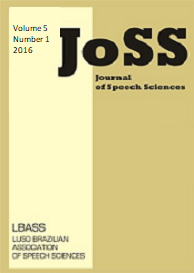Abstract
This paper reports an experimental study on the impact of time-compressed speech on acceptability and intelligibility of utterances in Brazilian Portuguese. For the experiments, short audio sentences containing warning messages were used as stimuli. These sentences were recorded in a natural speech rate and then digitally manipulated to faster rates in a scalar fashion (from 9 to 19 syllables per second). Intelligibility and acceptability tests were then conducted with blind and sighted subjects. The results indicate that time-compressed speech has a significant impact on both acceptability and intelligibility of utterances for both groups of participants and that while blind subjects tended to give slightly higher acceptability rates across all speech rate conditions, sighted subjects performed better in the intelligibility experiment, what contradicts a trend that is often reported in the literatureReferences
ANVISA. Regulation about pharmaceutical drug advertising. Online: http://portal.anvisa.gov.br/wps/wcm/connect/b12a03004745973d9f9adf3fbc4c6735/rdc_9608_comentada.pd f?MOD=AJPERES, accessed on 04 Feb 2015.
V. O. Martins and C. F. Andrade, “Perfil evolutivo da fluência da fala de falantes do Português brasileiro,” Pró-Fono Revista de Atualização Científica, vol. 20, no. 1, pp. 7–12, 2008.
M. Oliveira Jr., Prosodic Features in Spontaneous Narratives. Thesis (PhD). Simon Fraser University, Vanvouver, Canada, 2000.
J. Trouvain, “On the comprehension of extremely fast synthetic speech,” Saarland Working Papers in Linguistics (SWPL), vol. 1, pp. 5–13, 2007.
A. Moos and J. Trouvain, “Comprehension of Ultra-Fast Speech - Blind vs. ‘Normally Hearing’ Persons,” Proceedings of the 16th International Congress of Phonetic Sciences, Saarbrücken, 2007, pp. 677–680.
S. Dietrich, I. Hertrich, and H. Ackermann, “Training of ultra-fast speech comprehension induces functional reorganization of the central-visual system in late-blind humans,” Frontiers in Human Neuroscience, vol. 7, article 701, 2013.
S. Dietrich, I. Hertrich, and H. Ackermann, “Ultra-fast speech comprehension in blind subjects engages primary visual cortex, fusiform gyrus, and pulvinar - a functional magnetic resonance imaging (fMRI) study,” BMC Neuroscience, vol. 14, article 74, 2013.
E. Janse, Production and perception of fast speech. Utrecht: LOT, 2003.
C. Asakawa, H. Takagi, S. Ino, and T. Ifukube, “Maximum listening speeds for the blind,” Proceedings of the 2003 International Conference on Auditory Display, (ICAD03), Boston, 2003, pp. 276–279.
W. D. Garvey, “The intelligibility of speeded speech,” Journal of Experimental Psychology, vol. 45, no. 2, pp. 102–108, 1953.
G. Fairbanks, W. L. Everitt, and R. P. Jaeger, “Method for time or frequency compression-expansion of speech,” in S. Duker (Ed.), Time-compressed speech, vol. 1, pp. 172–180. Metuchen, N.J.: Scarecrow, 1974.
E. Foulke, The comprehension of rapid speech by the blind, part III, 1969. Online: http://files.eric.ed.gov/fulltext/ED034346.pdf, accessed on 25 Feb 2015.
A. Schmidt-Nielsen, “Intelligibility and Acceptability testing for Speech Technology,” Naval Research Laboratory, 1992. Online: http://www.dtic.mil/dtic/tr/fulltext/u2/a252015.pdf, accessed on 24 Feb 2015.
O. Ghitza and S. Greenberg, “On the possible role of brain rhythms in speech perception: intelligibility of time-compressed speech with periodic and aperiodic insertions of silence,” Phonetica, vol. 66, no. 1–2, pp. 113–126, 2009.
B. Sutton, J. King, K. Hux, and D. Beukelman, “Younger and older adults rate performance when listening to synthetic speech,” Augmentative and Alternative Communication, vol. 11, no. 3, pp. 147–153, 1995.
E. Janse, M. Van der Werff, and H. Quené, “Listening to fast speech: aging and sentence context,” in J. Trouvain and W. J. Barry (Eds.), Proceedings of the 16th International Congress of Phonetic Sciences, 2007, pp. 681–684.
A. Moos, I. Hertrich, S. Dietrich, J. Trouvain, and H. Ackermann, “Perception of Ultra-Fast Speech by a Blind Listener – Does He Use His Visual System?,” Proceedings of the 8th International Seminar on Speech Production, ISSP, 2008, pp. 297–300.
S. Kowal, S. Wiese, and D. O’Connell, “The use of time in storytelling,” Language and Speech, vol. 26, no. 4, pp. 377–392, 1983.
P. Boersma, “Praat, a system for doing phonetics by computer,” Glot International, vol. 5, no. 9–10, pp. 341–345, 2001.
R. Corretge, Praat vocal toolkit [Computer Software]. Barcelona. praatvocaltoolkit.com, 2012.
E. Blaauw, On the perceptual classification of spontaneous and read speech. Research Institute for Language and Speech, Utrecht University, 1995.
J. Fon, “Speech rate as a reflection of variance and invariance in conceptual planning in storytelling,” Proceeding of the ICPhS, San Francisco, vol. 14, no. 1, pp. 663–666, 1999.
M. Van Donzel, Prosodic Aspects of Information Structure in Discourse. Thesis (PhD). Faculteit der Geesteswetenschappen, University of Amsterdam, Amsterdam, 1999.
D. C. O'Connell and T. D. Kowal, “Cross-linguistic pause and rate phenomena in adults and adolescents,” Journal of Psycholinguistic Research, vol. 1, no. 2, pp. 155–164, 1972.
P. A. Dagenais, G. R. Brown, and R. E. Moore, “Speech rate effects upon intelligibility and acceptability of dysarthric speech,” Clinical Linguistics & Phonetics, vol. 20, no. 2–3, pp. 141–148, 2006.
E. B. Carne, A professional's guide to data communication in a TCP/IP world. Boston: Artech House, 2004.
A. D. Baddeley and G. J. Hitch, “Development of working memory: should the Pascual Leone and the Baddeley and Hitch models be merged?,” Journal of Experimental Child Psychology, vol. 77, no. 2, pp. 128–137, 2000.
P. E. King and R. R. Behnke, “The Effect of Time- Compressed Speech on Comprehensive, Interpretive, and Short- Term Listening,” Human Communication Research, vol. 15, no. 3, pp. 428–443, 1989.
M. J. Beatty, R. R. Behnke, and D. L. Froelich, “Effects of achievement incentive and presentation rate on listening comprehension,” Quarterly Journal of Speech, vol. 66, no. 2, pp. 193–200, 1980.

This work is licensed under a Creative Commons Attribution 4.0 International License.
Copyright (c) 2016 Miguel Oliveira Junior, Ayane Nazarela Santos de Almeida, René Alain Santana de Almeida, Oyedeji Musiliyu

